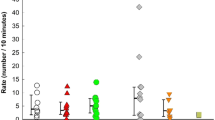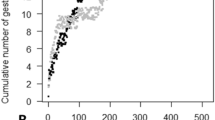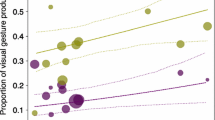Abstract
Contemporary research hypothesizes that biological inheritance and ontogenetic factors shape the development of gestural communication in nonhuman great apes. However, little is known about the specific role that mothers play in the acquisition of their infants’ gestures. We observed 6 bonobo (Pan paniscus) and 4 chimpanzee (Pan troglodytes) mother–infant dyads and recorded their gesture types and frequency. We analyzed all behavioral contexts in which gestures occurred as well as the play context alone. Infants of both species were unlikely to share gestures with their mother or unrelated adult females. However, gestural sharing was prevalent within age groups. Within and across species, infant–infant and mother–mother groups were homogeneous regarding the types of gestures they shared, although there was individual variation in the frequency of gesture use. Our findings provide limited evidence that infants learned their gestures by imitating their mothers. Phylogenetic influences seem to be vital in gestural acquisition but, we suggest, repertoire development cannot be disentangled from individual social encounters during life.



Similar content being viewed by others
References
Adams, D. C., & Anthony, C. D. (1996). Using randomisation techniques to analyse behavioural data. Animal Behaviour, 51, 733–738.
Altman, D. G. (1991). Practical statistics for medical research. London: Chapman & Hall.
Altmann, J. (1974). Observational study of behavior: Sampling methods. Behaviour, 49, 227–267.
Bard, K. A. (1992). Intentional behavior and intentional communication in young free-ranging orangutans. Child Development, 63, 1186–1197.
Bates, E., Camaioni, L., & Volterra, V. (1975). The acquisition of performatives prior to speech. Merrill-Palmer Quarterly, 21, 205–226.
Bruner, J. S. (1981). Intention in the structure of action and interaction. In L. P. Lipsitt (Ed.), Advances in infancy research (Vol. 1, pp. 41–56). Norwood, NJ: Ablex.
Bruner, J. S. (1983). Child’s talk. New York: W. W. Norton.
Butterworth, G. (2003). Pointing is the royal road to language for babies. In S. Kita (Ed.), Pointing: Where language, culture, and cognition meet (pp. 9–33). Mahwah, NJ: Erlbaum.
Call, J., & Tomasello, M. (2007a). Comparing the gestures of apes and monkeys. In J. Call & M. Tomasello (Eds.), The gestural communication of apes and monkeys (pp. 197–220). Mahwah, NJ: Lawrence Erlbaum.
Call, J., & Tomasello, M. (2007b). The gestural communication of apes and monkeys. Mahwah, NJ: Lawrence Erlbaum.
Cartmill, E. A. (2008). Gestural communication in orangutans (Pongo pygmaeus and Pongo abelii): A cognitive approach. St. Andrews: University of St. Andrews.
Cavalli-Sforza, L. L., & Feldman, M. W. (1981). Cultural transmission and evolution: A quantitative approach. Princeton, NJ: Princeton University Press.
Dice, L. R. (1945). Measures of the amount of ecologic association between species. Ecology, 26, 297–302.
Enquist, M., Strimling, P., Eriksson, K., Laland, K., & Sjostrand, J. (2010). One cultural parent makes no culture. Animal Behaviour, 79, 1353–1362.
Genty, E., Breuer, T., Hobaiter, C., & Byrne, R. W. (2009). Gestural communication of the gorilla (Gorilla gorilla): Repertoire, intentionality and possible origins. Animal Cognition, 12, 527–546.
Gomm, R., Hammersley, M., & Foster, P. (2000). Case study method. London: SAGE.
Haccou, P., & Meelis, E. (1994). Statistical analyses of behavioural data. Oxford: Oxford University Press.
Hirata, S., & Celli, M. L. (2003). Role of mothers in the acquisition of tool-use behaviours by captive infant chimpanzees. Animal Cognition, 6, 235–244.
Hobaiter, C., & Byrne, R. W. (2011). The gestural repertoire of the wild chimpanzee. Animal Cognition, 14, 745–767.
Hoff, M. P., Nadler, R. D., & Maple, T. L. (1981). Development of infant independence in a captive group of lowland gorillas. Developmental Psychobiology, 14, 251–265.
Jaeggi, A. V., Dunkel, L. P., van Noordwijk, M. A., Wich, S. A., Sura, A. A. L., & van Schaik, C. P. (2010). Social learning of diet and foraging skills by wild immature Bornean orangutans: Implications for culture. American Journal of Primatology, 72, 62–71.
King, B. J. (2004). The dynamic dance: Nonvocal communication in African great apes. Cambridge, MA: Harvard University Press.
Liebal, K., & Call, J. (2012). The origins of nonhuman primates' manual gestures. Philosophical Transactions of the Royal Society B: Biological Sciences, 367, 118–128.
Liebal, K., Pika, S., & Tomasello, M. (2006). Gestural communication of orangutans (Pongo pygmaeus). Gesture, 6, 1–38.
Liszkowski, U. (2008). Before L1: A differentiated perspective on infant gestures. Gesture, 8, 180–196.
Lonsdorf, E. V. (2006). What is the role of mothers in the acquisition of termite-fishing behaviors in wild chimpanzees (Pan troglodytes schweinfurthii)? Animal Cognition, 9, 36–46.
Maestripieri, D., & Call, J. (1996). Mother-infant communication in primates. Advances in the Study of Behavior, 25, 613–642.
Manly, B. F. J. (1997). Randomization, bootstrap and Monte Carlo methods in biology. New York: Chapman & Hall.
Mason, W. A. (1963). The effects of environmental restriction on the social development of rhesus monkeys. In C. H. Southwick (Ed.), Primate social behaviour (pp. 161–173). New York: Van Nostrand.
Masur, E. F. (1980). The development of communicative gestures in mother-infant interactions. Papers and Reports on Child Language Development, 19, 121–128.
Pereira, M. E., & Fairbanks, L. A. (2002). Juvenile primates: Life history, development, and behavior. Chicago: The University of Chicago Press.
Pika, S., Liebal, K., & Tomasello, M. (2003). Gestural communication in young gorillas (Gorilla gorilla): Gestural repertoire, learning, and use. American Journal of Primatology, 60, 95–111.
Pika, S., Liebal, K., Call, J., & Tomasello, M. (2005a). The gestural communication of apes. Gesture, 5, 39–54.
Pika, S., Liebal, K., & Tomasello, M. (2005b). Gestural communication in subadult bonobos (Pan paniscus): Repertoire and use. American Journal of Primatology, 65, 39–61.
Plooij, F. X. (1978). Some basic traits of language in wild chimpanzees? In A. Lock (Ed.), Action, gesture and symbol: The emergence of language (pp. 111–131). London: Academic Press.
Plooij, F. X. (1984). The behavioral development of free-living chimpanzee babies and infants. Norwood, NJ: Ablex.
R Development Core Team. (2009). R: A language and environment for statistical computing. Vienna, Austria: R Foundation for Statistical Computing.
Redshaw, M., & Locke, K. (1976). The development of play and social behaviour in two lowland gorilla infants. Journal of the Jersey Wildlife Preservation Trust, 13th Annual Report, 71–86.
Rogers, L. J., & Kaplan, G. (2000). Songs, roars, and rituals: Communication in birds, mammals, and other animals. Cambridge, MA: Harvard University Press.
Schneider, C., Call, J., & Liebal, K. (2011). Onset and early use of gestural communication in nonhuman great apes. American Journal of Primatology, 73, 1–12.
Smith, W. J. (1977). The behavior of communicating: An ethological approach. Cambridge, MA: Harvard University Press.
Sokal, R. R., & Rohlf, F. J. (1995). Biometry: The principles and practice of statistics in biological research (3rd ed.). New York: W. H. Freeman.
Tomasello, M., & Call, J. (1997). Primate cognition. New York: Oxford University Press.
Tomasello, M., Call, J., Nagell, K., Olguin, R., & Carpenter, M. (1994). The learning and use of gestural signals by young chimpanzees: A trans-generational study. Primates, 35, 137–154.
Tomasello, M., Call, J., Warren, J., Frost, G. T., Carpenter, M., & Nagell, K. (1997). The ontogeny of chimpanzee gestural signals: A comparison across groups and generations. Evolution of Communication, 1, 223–259.
Tomasello, M., George, B. L., Kruger, A. C., Farrar, M. J., & Evans, A. (1985). The development of gestural communication in young chimpanzees. Journal of Human Evolution, 14, 175–186.
Tomasello, M., Gust, D., & Frost, G. T. (1989). A longitudinal investigation of gestural communication in young chimpanzees. Primates, 30, 35–50.
van Lawick-Goodall, J. (1967). Mother-offspring relationships in free-ranging chimpanzees. In D. Morris (Ed.), Primate ethology (pp. 287–346). London: Weidenfeld and Nicolson.
van Schaik, C. (2004). Among orangutans: Red apes and the rise of human culture. Cambridge, MA: The Belknap Press of Harvard University Press.
Watts, D. P., & Pusey, A. E. (2002). Behavior of juvenile and adolescent great apes. In M. E. Pereira & L. A. Fairbanks (Eds.), Juvenile primates: Life history, development, and behavior (pp. 148–167). New York: Oxford University Press.
Wetherby, A. M., Cain, D. H., Yonclas, D. G., & Walker, V. G. (1988). Analysis of intentional communication of normal children from the prelinguistic to the multiword stage. Journal of Speech and Hearing Research, 31, 240–252.
Wich, S. A., Utami-Atmoko, S. S., Mitra Setia, T., Rijksen, H. D., Schürmann, C., van Hooff, J. A. R. A. M., & van Schaik, C. P. (2004). Life history of wild Sumatran orangutans (Pongo abelii). Journal of Human Evolution, 47, 385–398.
Zentall, T. R. (2006). Imitation: Definitions, evidence, and mechanisms. Animal Cognition, 9, 335–353.
Acknowledgements
We are especially grateful to Apenheul and Burgers’ Zoo (Holland), Dierenpark Planckendael (Belgium), Zoo Leipzig, Zoo Berlin, and Allwetterzoo Muenster (Germany) for their support and friendliness. We thank M. Chase and H. Gretscher for fruitful discussions and comments on earlier drafts of this manuscript. We express a special thanks to R. Mundry for his ideas and time regarding the statistical procedures. We also thank the reviewers for their helpful comments. This study was part of the interdisciplinary research project Towards a Grammar of Gesture, which was funded by the Volkswagen Foundation (Hannover, Germany).
Author information
Authors and Affiliations
Corresponding author
Electronic supplementary materials
Below is the link to the electronic supplementary material.
ESM 1
(DOC 123 kb)
Rights and permissions
About this article
Cite this article
Schneider, C., Call, J. & Liebal, K. What Role Do Mothers Play in the Gestural Acquisition of Bonobos (Pan paniscus) and Chimpanzees (Pan troglodytes)?. Int J Primatol 33, 246–262 (2012). https://doi.org/10.1007/s10764-011-9570-3
Received:
Accepted:
Published:
Issue Date:
DOI: https://doi.org/10.1007/s10764-011-9570-3




